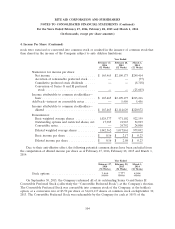Rite Aid 2016 Annual Report Download - page 114
Download and view the complete annual report
Please find page 114 of the 2016 Rite Aid annual report below. You can navigate through the pages in the report by either clicking on the pages listed below, or by using the keyword search tool below to find specific information within the annual report.RITE AID CORPORATION AND SUBSIDIARIES
NOTES TO CONSOLIDATED FINANCIAL STATEMENTS (Continued)
For the Years Ended February 27, 2016, February 28, 2015 and March 1, 2014
(In thousands, except per share amounts)
7. Income Taxes (Continued)
The Company’s federal and state net operating loss carryforwards include federal deductions of
$18,365 and state deductions of $79,442 for windfall tax benefits that have not yet been recognized in
the financial statements at February 27, 2016. These tax benefits will be credited to additional paid-in
capital when they reduce current taxable income consistent with the tax law ordering approach.
At February 27, 2016, the Company had federal business tax credit carryforwards of $50,165, the
majority of which will expire between 2019 and 2021. In addition to these credits, the Company had
alternative minimum tax credit carryforwards of $3,234.
Valuation Allowances
The valuation allowances as of February 27, 2016 and February 28, 2015 apply to the net deferred
tax assets of the Company. The Company maintained a valuation allowance of $212,023 and $231,679,
which relates primarily to state deferred tax assets at February 27, 2016 and February 28, 2015,
respectively.
8. Accounts Receivable
The Company maintains an allowance for doubtful accounts receivable based upon the expected
collectability of accounts receivable. The allowance for uncollectible accounts at February 27, 2016 and
February 28, 2015 was $32,820 and $31,247 respectively. The Company’s accounts receivable are due
primarily from third-party payors (e.g., pharmacy benefit management companies, insurance companies
or governmental agencies) and are recorded net of any allowances provided for under the respective
plans. Since payments due from third-party payors are sensitive to payment criteria changes and
legislative actions, the allowance is reviewed continually and adjusted for accounts deemed uncollectible
by management.
9. Medicare Part D
The Company offers Medicare Part D benefits through EIC, which has contracted with CMS to be
a PDP and, pursuant to the Medicare Prescription Drug, Improvement and Modernization Act of 2003,
must be a risk-bearing entity regulated under state insurance laws or similar statutes.
EIC is a licensed domestic insurance company under the applicable laws and regulations. Pursuant
to these laws and regulations, EIC must file quarterly and annual reports with the National Association
of Insurance Commissioners (‘‘NAIC’’) and certain state regulators, must maintain certain minimum
amounts of capital and surplus under formulas established by certain states and must, in certain
circumstances, request and receive the approval of certain state regulators before making dividend
payments or other capital distributions to the Company. The Company does not believe these
limitations on dividends and distributions materially impact its financial position. EIC is subject to
minimum capital and surplus requirements in certain states. The minimum amount of capital and
surplus required to satisfy regulatory requirements in these states is $19,627 as of December 31, 2015.
EIC was in excess of the minimum required amounts in these states as of February 27, 2016.
114
























